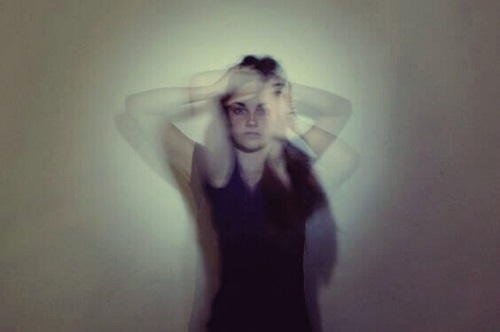Depersonalization Disorder: The Feeling of Living in a Dream

If you’ve ever felt like you were going crazy or that you were in a dream or in a bubble, you may have suffered an episode of depersonalization. The main characteristic of depersonalization disorder are persistent or recurring depersonalization episodes.
During these episodes, you might experience a sense of unreality or unfamiliarity. In addition, you might feel detached from yourself. The sufferers feel like they’re external observers.
Depersonalization episodes
Depersonalization episodes bring a sense of unreality or detachment. You may also feel as if you’re not familiar with the world, inanimate objects, or your surroundings. You might feel as if you’re in a fog, a dream, or a bubble. Also, you may feel as if there was a veil or a glass wall between yourself and the world around you. You might see your environment as artificial, colorless, or lifeless.

Depersonalization is usually accompanied by subjective visual distortions such as blurred vision, increased visual acuity, enlarged or reduced visual field, two-dimensionality or flatness, exaggeration of three-dimensionality, or changes in the distance or size of objects (e.g., macropsia or micropsia).
Depersonalization disorder can affect your social life or work life.
Am I going crazy?
People with depersonalization disorder may have difficulty describing their symptoms. They may think they are “crazy” or “going crazy” or fear irreversible brain damage.
A common associated symptom is a subjective change of one’s sense of time (e.g. time is passing too slow or too fast). Another common symptom is difficulty vividly remembering things from the past.
Headaches, tingling, or dizziness are also not uncommon. People may also suffer from obsessive worrying and rumination.
In this case, people become obsessed about whether they really exist or control their perceptions. This is often associated with different degrees of anxiety and depression. People with this disorder also tend to have a physiological hypo-responsiveness to emotional stimuli.

How does this disorder develop?
The average age of onset for depersonalization disorder is sixteen. However, the disorder can manifest in early or mid-childhood.
Less than twenty percent of cases develop after the age of twenty and only five percent after the age of twenty-five. Development at age forty or later is very infrequent. On the other hand, the onset of the disorder can be gradual or extremely sudden. The episodes can last hours or days to weeks, months, or years.
While for some people the intensity of the symptoms can increase and decrease considerably, others experience a consistent level of intensity. In extreme cases, the symptoms can last for years or decades.
The internal and external factors that affect the intensity of symptoms vary widely, although there are some typical patterns. Symptoms can be worsened by stress, mood, anxiety symptoms, new stimulating or overstimulating circumstances, and by physical factors such as lack of sleep.
Depersonalization disorder can be extremely unpleasant. Those who suffer from it usually feel as if they’re going crazy or living in a dream, which can make them seek medical help. Fortunately, it isn’t dangerous.
If you’ve ever felt like you were going crazy or that you were in a dream or in a bubble, you may have suffered an episode of depersonalization. The main characteristic of depersonalization disorder are persistent or recurring depersonalization episodes.
During these episodes, you might experience a sense of unreality or unfamiliarity. In addition, you might feel detached from yourself. The sufferers feel like they’re external observers.
Depersonalization episodes
Depersonalization episodes bring a sense of unreality or detachment. You may also feel as if you’re not familiar with the world, inanimate objects, or your surroundings. You might feel as if you’re in a fog, a dream, or a bubble. Also, you may feel as if there was a veil or a glass wall between yourself and the world around you. You might see your environment as artificial, colorless, or lifeless.

Depersonalization is usually accompanied by subjective visual distortions such as blurred vision, increased visual acuity, enlarged or reduced visual field, two-dimensionality or flatness, exaggeration of three-dimensionality, or changes in the distance or size of objects (e.g., macropsia or micropsia).
Depersonalization disorder can affect your social life or work life.
Am I going crazy?
People with depersonalization disorder may have difficulty describing their symptoms. They may think they are “crazy” or “going crazy” or fear irreversible brain damage.
A common associated symptom is a subjective change of one’s sense of time (e.g. time is passing too slow or too fast). Another common symptom is difficulty vividly remembering things from the past.
Headaches, tingling, or dizziness are also not uncommon. People may also suffer from obsessive worrying and rumination.
In this case, people become obsessed about whether they really exist or control their perceptions. This is often associated with different degrees of anxiety and depression. People with this disorder also tend to have a physiological hypo-responsiveness to emotional stimuli.

How does this disorder develop?
The average age of onset for depersonalization disorder is sixteen. However, the disorder can manifest in early or mid-childhood.
Less than twenty percent of cases develop after the age of twenty and only five percent after the age of twenty-five. Development at age forty or later is very infrequent. On the other hand, the onset of the disorder can be gradual or extremely sudden. The episodes can last hours or days to weeks, months, or years.
While for some people the intensity of the symptoms can increase and decrease considerably, others experience a consistent level of intensity. In extreme cases, the symptoms can last for years or decades.
The internal and external factors that affect the intensity of symptoms vary widely, although there are some typical patterns. Symptoms can be worsened by stress, mood, anxiety symptoms, new stimulating or overstimulating circumstances, and by physical factors such as lack of sleep.
Depersonalization disorder can be extremely unpleasant. Those who suffer from it usually feel as if they’re going crazy or living in a dream, which can make them seek medical help. Fortunately, it isn’t dangerous.
This text is provided for informational purposes only and does not replace consultation with a professional. If in doubt, consult your specialist.







